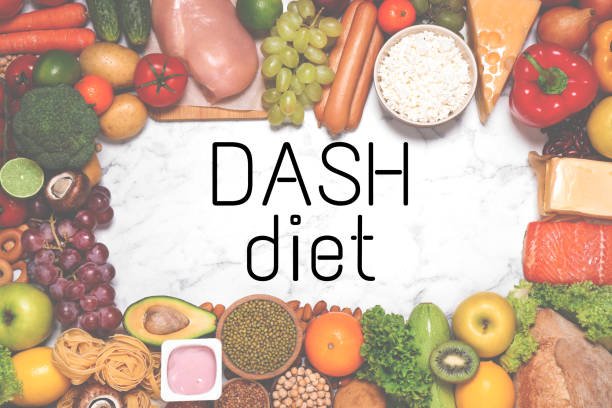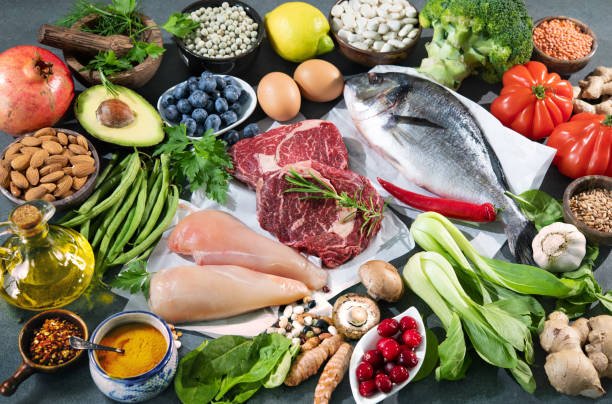
Dietary approaches to stop hypertension. Many different healthy food around words Dash diet on white marble table, flat lay. Light toned design
Welcome to a journey of health and vitality as we unravel the secrets of the DASH Diet—your key to better heart health. The DASH Diet, standing for Dietary Approaches To Stop Hypertension, is not just a diet; it’s a holistic approach to managing blood pressure and fostering overall well-being.
The Dash Diet Stands for Dietary Approaches To Stop
A. Brief Overview of the DASH Diet
The DASH Diet emerged as a response to the pressing need for effective strategies to combat hypertension. Developed by the National Heart, Lung, and Blood Institute (NHLBI), this dietary approach has proven its efficacy in not only stopping hypertension but also promoting heart health.
B. Importance of Dietary Approaches To Stop
Addressing Hypertension
Hypertension, or high blood pressure, is a prevalent health concern with serious implications for cardiovascular health. The DASH Diet offers a proactive and natural way to manage and prevent hypertension through mindful dietary choices.
Overall Heart Health Benefits
Beyond its primary focus on blood pressure, the DASH Diet provides a roadmap to comprehensive heart health. By emphasizing nutrient-rich foods and a balanced approach to nutrition, it contributes to overall well-being.
II. Understanding Hypertension
A. What Is Hypertension?
Definition and Causes
Hypertension is a medical condition characterized by elevated blood pressure levels. Chronic hypertension can strain the heart, arteries, and organs, increasing the risk of serious health issues such as heart disease and stroke. Causes include genetic factors, lifestyle choices, and underlying health conditions.
Health Implications
Untreated hypertension can lead to severe complications, including damage to the heart, kidneys, and blood vessels. It is often referred to as a “silent killer” because it may not exhibit noticeable symptoms until significant damage has occurred.
B. The Role of Diet in Managing Hypertension
Connection Between Diet and Blood Pressure
Diet plays a pivotal role in managing hypertension. High sodium intake, along with a lack of key nutrients, can contribute to elevated blood pressure. The DASH Diet addresses these factors by promoting a balanced and heart-healthy approach to eating.
Lifestyle Changes for Hypertension Control
In addition to dietary adjustments, lifestyle modifications such as regular physical activity, stress management, and limiting alcohol intake are crucial components of hypertension control. The holistic nature of the DASH Diet aligns with these broader health principles.
III. Deconstructing the DASH Acronym
A. Dietary
Overview of Dietary Components
The “D” in DASH stands for “Dietary,” emphasizing the importance of mindful eating. The DASH Diet encourages the consumption of nutrient-rich foods while limiting sodium intake. Key components include fruits, vegetables, whole grains, lean proteins, and dairy or dairy alternatives.
Importance of Balanced Nutrition
A balanced intake of essential nutrients is fundamental to the DASH Diet. By prioritizing a variety of food groups, individuals can ensure they receive the necessary vitamins, minerals, and antioxidants crucial for heart health.
B. Approaches
Flexible Approaches to Eating
Unlike restrictive diets, the DASH Diet offers flexibility. It accommodates various dietary preferences and cultural practices, making it adaptable to different lifestyles. This flexibility enhances adherence and sustainability.
Adaptable to Different Lifestyles
Whether you’re a busy professional, a parent, or someone with specific dietary preferences, the DASH Diet provides approaches that can be tailored to diverse lifestyles. This adaptability makes it accessible to a broad audience.
C. To Stop
How DASH Aims to Stop Hypertension
The ultimate goal of the DASH Diet is to halt the progression of hypertension and reduce the risk of associated complications. It achieves this by promoting healthy eating habits that contribute to optimal blood pressure levels.
Long-term Health Benefits
While the immediate focus is on blood pressure control, the DASH Diet’s positive impact extends beyond hypertension. Adopting this dietary approach can lead to long-term health benefits, including weight management, improved cholesterol levels, and enhanced overall cardiovascular health.
IV. Core Principles of the DASH Diet
A. Emphasis on Fruits and Vegetables
Types and Portions
Fruits and vegetables form the cornerstone of the DASH Diet. Rich in vitamins, minerals, and antioxidants, they contribute to heart health. Aim for a variety of colorful options, and consider portion sizes to ensure a well-balanced plate.
Nutritional Benefits
The nutritional benefits of fruits and vegetables are vast. They provide essential nutrients, fiber, and compounds with antioxidant properties. These elements collectively support heart health, reduce inflammation, and contribute to overall well-being.
B. Whole Grains for Heart Health
Importance of Whole Grains
Whole grains, such as brown rice, quinoa, and whole wheat, play a crucial role in the DASH Diet. They offer a spectrum of nutrients, including fiber, which aids in digestion and helps regulate blood pressure.
Examples and Serving Recommendations
Incorporate whole grains into your meals through choices like whole grain bread, brown rice, and oatmeal. Aim for at least three servings per day to maximize the heart-healthy benefits.
C. Lean Proteins in the DASH Diet
Optimal Protein Sources
Protein is an essential component of the DASH Diet, contributing to muscle health and satiety. Opt for lean protein sources such as poultry, fish, beans, and nuts to minimize saturated fat intake.
Quantity and Frequency
Strike a balance by incorporating lean proteins into your meals regularly. Pay attention to portion sizes, and consider plant-based protein sources as alternatives for added variety.
D. Incorporating Dairy or Alternatives
Role of Dairy in DASH
Dairy products provide essential nutrients like calcium and vitamin D. The DASH Diet includes options for dairy or alternatives, ensuring individuals can meet their nutritional needs based on their preferences and dietary restrictions.
Options for Lactose-Intolerant Individuals
For those who are lactose intolerant, there are various dairy alternatives available, such as fortified plant-based milk. These alternatives offer similar nutritional benefits without compromising on taste.
E. Monitoring Sodium Intake
Understanding Sodium’s Impact
High sodium intake is a common contributor to elevated blood pressure. The DASH Diet addresses this by recommending sodium reduction to support heart health. Understanding the sources of sodium and making informed choices is essential.
Practical Tips for Reducing Sodium
Limiting processed foods, choosing fresh ingredients, and seasoning meals with herbs and spices are effective strategies for reducing sodium intake. Reading food labels and being mindful of restaurant choices also contribute to overall sodium awareness.
V. DASH Diet in Action
A. Sample DASH Diet Meal Plan
Breakfast, Lunch, Dinner, and Snack Ideas
Let’s bring the DASH Diet to life with a sample meal plan:
Breakfast:
- Greek yogurt with berries and a sprinkle of nuts
- Whole grain toast with avocado
Lunch:
- Grilled chicken salad with a variety of colorful vegetables
- Quinoa as a side dish
Dinner:
- Baked salmon with lemon and herbs
- Steamed broccoli and brown rice
Snack:
- Fresh fruit
- Handful of mixed nuts
Variety and Flexibility
The beauty of the DASH Diet lies in its variety and flexibility. Feel free to adapt this sample meal plan to suit your taste preferences and dietary requirements. The key is to prioritize nutrient-rich foods and maintain a well-balanced approach.
B. Tips for Adhering to the DASH Diet
Grocery Shopping Guidance
Navigating the grocery store can be overwhelming, but a few tips can simplify the process:
- Stick to the Perimeter: Fresh produce, lean proteins, and dairy are typically located around the store’s perimeter.
- Read Labels: Pay attention to nutritional labels, especially for sodium content.
- Plan Ahead: Create a shopping list based on your meal plan to stay focused.
Eating Out While Following DASH
Maintaining the DASH Diet when dining out requires some strategic choices:
- Choose Grilled Options: Opt for grilled proteins instead of fried.
- Request Modifications: Don’t hesitate to ask for modifications, such as substituting sides with vegetables.
- Be Mindful of Sauces: Ask for sauces and dressings on the side to control sodium intake.
VI. Scientific Backing and Research
A. Studies Supporting the DASH Diet
Clinical Findings
Numerous studies have demonstrated the effectiveness of the DASH Diet in reducing blood pressure levels. A landmark clinical trial sponsored by the NHLBI found that individuals following the DASH Diet experienced significant reductions in both systolic and diastolic blood pressure.
Endorsements by Health Organizations
Health organizations, including the American Heart Association (AHA) and the World Health Organization (WHO), endorse the DASH Diet for its evidence-based approach to heart health. These endorsements underscore the diet’s credibility and reliability as a means of promoting cardiovascular well-being.
VII. Potential Challenges and Considerations
A. Addressing Common Concerns
Perceived Restrictions
One common concern about the DASH Diet is the perception of restrictions. While the diet emphasizes specific food choices, it allows for flexibility and adaptation based on individual preferences. The focus is on making sustainable, long-term changes rather than adhering to rigid rules.
Adaptation Period
As with any dietary change, individuals may experience an adaptation period. This period allows the body to adjust to a new way of eating. It’s essential to approach the DASH Diet with patience and a commitment to long-term health.
B. Consultation with Healthcare Professionals
Importance of Professional Guidance
Before embarking on any significant dietary change, it’s advisable to consult with healthcare professionals, such as registered dietitians or physicians. They can provide personalized guidance based on individual health conditions, ensuring the DASH Diet aligns with specific needs.
Customizing the DASH Diet to Individual Health Needs
The DASH Diet is adaptable and can be customized to accommodate various health conditions and dietary requirements. Healthcare professionals can offer insights into modifications that may be necessary for individuals with specific health concerns.
VIII. Success Stories and Testimonials
A. Real-life Experiences
Personal Transformations
Real-life success stories highlight the transformative power of the DASH Diet. Individuals have shared experiences of significant improvements in blood pressure, weight management, and overall well-being. These stories serve as inspiration for those considering adopting the DASH Diet.
Lessons Learned
Success stories often include valuable lessons learned along the way. From discovering new favorite recipes to experiencing increased energy levels, individuals share insights that can motivate others on their DASH Diet journey.
IX. Frequently Asked Questions (FAQs)
A. Common Queries About the DASH Diet
Clarifying Misconceptions
Let’s address some common questions and misconceptions about the DASH Diet:
Q: Is the DASH Diet Only for People with Hypertension? A: While the DASH Diet is particularly beneficial for managing hypertension, its principles promote overall heart health. Individuals without hypertension can also adopt the DASH Diet as a preventive measure.
Q: Is the DASH Diet Suitable for Vegetarians? A: Absolutely. The DASH Diet is flexible and can be adapted to various dietary preferences, including vegetarian and vegan lifestyles. Plant-based protein sources align well with the diet’s principles.
Q: Can I Still Enjoy Flavorful Meals on the DASH Diet? A: Yes. The DASH Diet encourages the use of herbs, spices, and other flavorful ingredients to enhance the taste of meals. Experimenting with seasonings can make DASH-approved meals both nutritious and delicious.
Practical Implementation Tips
As you embark on your DASH Diet journey, keep these practical tips in mind:
- Start Gradually: Introduce DASH principles gradually to allow for a smoother transition.
- Experiment with Recipes: Explore new recipes to keep your meals interesting and satisfying.
- Stay Hydrated: Adequate hydration is essential for overall health and complements the DASH Diet’s principles.
The DASH Diet: A Heart-Healthy Approach to Lowering Hypertension
The Dietary Approaches to Stop Hypertension (DASH) diet is not just a fad diet but a well-researched and evidence-based dietary plan designed to reduce high blood pressure and promote overall heart health. Hypertension, or high blood pressure, is a prevalent condition that can lead to serious health complications, including heart disease, stroke, and kidney problems. The DASH diet was developed to address this critical health issue and provide individuals with a practical and sustainable way to manage their blood pressure.
The Origins of the DASH Diet
The DASH diet was developed by the National Heart, Lung, and Blood Institute (NHLBI) as part of a research study known as the DASH-Sodium trial. The study aimed to investigate the effects of dietary patterns on blood pressure, and the results were groundbreaking. The DASH diet, initially developed in the 1990s, proved to be highly effective in reducing blood pressure, and it has since become one of the most recommended dietary plans for individuals with hypertension.
Key Components of the DASH Diet
The DASH diet is characterized by several key components that emphasize nutrient-rich, heart-healthy foods:
1. High Consumption of Fruits and Vegetables:
One of the fundamental principles of the DASH diet is the inclusion of a wide variety of fruits and vegetables. These foods are rich in essential nutrients like potassium, magnesium, and fiber, which are known to help regulate blood pressure.
2. Whole Grains:
Whole grains like brown rice, whole wheat bread, and oats are encouraged in the DASH diet. They provide complex carbohydrates, fiber, and important minerals that contribute to overall heart health.
3. Lean Protein Sources:
Proteins in the DASH diet primarily come from lean sources such as poultry, fish, and plant-based alternatives like legumes and tofu. These protein sources are lower in saturated fat and beneficial for cardiovascular health.
4. Dairy with a Twist:
The DASH diet incorporates dairy products but often recommends low-fat or fat-free options to limit saturated fat intake. These dairy products are rich in calcium and are important for bone health.
5. Nuts, Seeds, and Legumes:
These are heart-healthy sources of protein and healthy fats that can help lower blood pressure. Almonds, walnuts, and flaxseeds are among the recommended choices.
6. Limited Sodium Intake:
Reducing sodium intake is a critical aspect of the DASH diet. High sodium consumption is strongly associated with hypertension, so the diet encourages limiting salt and processed food consumption.
7. Reduced Sugar:
The DASH diet discourages the consumption of sugary beverages and excessive sweets. Instead, it promotes natural sources of sweetness like fruits.
8. Moderation with Alcohol:
If you choose to drink alcohol, the DASH diet recommends doing so in moderation. For most adults, this means up to one drink per day for women and up to two drinks per day for men.
9. Healthy Fats:
The diet allows for the inclusion of healthy fats, such as those found in olive oil, avocados, and fatty fish. These fats support cardiovascular health.
The Science Behind the DASH Diet
The DASH diet has been extensively studied and proven to be effective in reducing blood pressure. Here’s a closer look at the scientific evidence supporting its benefits:
1. Blood Pressure Reduction:
The primary goal of the DASH diet is to lower blood pressure, and it consistently achieves this in research studies. The high intake of potassium and magnesium, combined with a low-sodium approach, helps reduce hypertension.
2. Heart Disease Risk Reduction:
By promoting heart-healthy foods, the DASH diet also lowers the risk of heart disease, including coronary artery disease and stroke. The emphasis on low-saturated fat and high-fiber foods contributes to these benefits.
3. Weight Management:
The diet can assist with weight management due to its focus on whole, nutrient-dense foods. Maintaining a healthy weight is crucial for heart health.
4. Diabetes Control:
The diet’s emphasis on whole grains, lean proteins, and controlled carbohydrate intake can help individuals with diabetes manage their blood sugar levels.
5. Improved Lipid Profile:
The DASH diet has been shown to improve lipid profiles by reducing levels of LDL (bad) cholesterol and increasing HDL (good) cholesterol.
Practical Tips for Following the DASH Diet
If you’re interested in adopting the diet to manage your blood pressure and improve your heart health, here are some practical tips to get you started:
1. Read Nutrition Labels:
Pay close attention to food labels and choose products that are low in sodium and saturated fat.
2. Limit Processed Foods:
Processed and pre-packaged foods are often high in sodium. Reducing your intake of these items is crucial.
3. Increase Fruit and Vegetable Intake:
Aim to include fruits and vegetables in every meal. Fresh, frozen, and canned (low sodium) options are all acceptable.
4. Choose Whole Grains:
Opt for whole grain options when selecting bread, pasta, rice, and cereals.
5. Select Lean Proteins:
Include sources of lean protein like poultry, fish, legumes, and tofu in your diet. Limit red meat consumption.
6. Use Healthy Fats:
Cook with olive oil or canola oil, and snack on nuts and seeds for healthy fats.
7. Moderate Dairy:
Choose low-fat or fat-free dairy products to reduce saturated fat intake.
8. Cut Back on Sugar:
Limit your consumption of sugary beverages and sweets.
9. Practice Portion Control:
Be mindful of portion sizes to avoid overeating.
10. Stay Hydrated:
Drink plenty of water and limit your intake of high-sugar drinks.
Conclusion
The DASH is a well-documented and effective approach to managing hypertension and promoting overall heart health. It’s not just a temporary fix but a sustainable way of eating that encourages the consumption of nutrient-rich, balanced meals.
By following the principles of the diet, individuals can take control of their blood pressure and reduce their risk of heart-related complications, ultimately leading to a healthier and longer life. It is advisable to consult with a healthcare professional or registered dietitian before starting any new dietary plan, especially if you have specific health concerns or conditions.
In summary, the DASH Diet is a powerful tool for promoting heart health through dietary approaches to stop hypertension. Its emphasis on nutrient-rich foods, balanced nutrition, and flexibility makes it a sustainable and effective choice for individuals seeking a holistic approach to well-being.







Another issue is that video games usually are serious as the name indicated with the major focus on mastering rather than leisure. Although, it comes with an entertainment part to keep your sons or daughters engaged, just about every game is frequently designed to focus on a specific set of skills or program, such as instructional math or scientific disciplines. Thanks for your write-up.
Excellent items from you, man. I’ve consider your stuff previous to and you are simply extremely great. I really like what you have acquired right here, really like what you’re stating and the best way by which you say it. You are making it enjoyable and you continue to care for to stay it smart. I can’t wait to learn much more from you. That is really a terrific website.
Yet another thing I would like to express is that as opposed to trying to suit all your online degree tutorials on times that you complete work (considering that people are exhausted when they get home), try to get most of your lessons on the weekends and only one or two courses on weekdays, even if it means a little time away from your weekend break. This is beneficial because on the week-ends, you will be extra rested plus concentrated in school work. Thx for the different guidelines I have figured out from your website.
I have been examinating out many of your articles and i can state pretty good stuff. I will surely bookmark your site.
I would like to thank you for the efforts you’ve put in writing this site. I’m hoping the same high-grade website post from you in the upcoming as well. In fact your creative writing skills has encouraged me to get my own website now. Actually the blogging is spreading its wings quickly. Your write up is a good example of it.
Can you be more specific about the content of your article? After reading it, I still have some doubts. Hope you can help me.
Can you be more specific about the content of your article? After reading it, I still have some doubts. Hope you can help me.